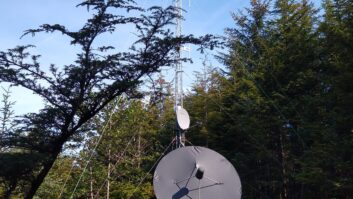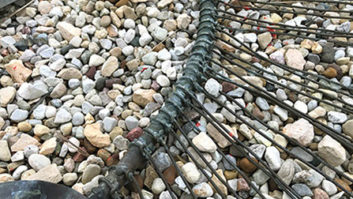Fred Greaves, Jr., is director of engineering for Susquehanna Radio Corp., and got a chuckle over our comments about FCC inspections and the inspectors. Fred adds a tip for chiefs of AM directionals.
A few years ago, an inspector insisted on taking harmonic measurements (yes, they are still required) in the null of the AM directional. As you know, this null is produced at carrier, not at the harmonics, and therefore a false attenuation is seen. If you don’t understand or agree with the inspector, politely ask for clarification.
Broadcast stations are but one small segment of the inspector’s realm of stations: ships, amateur, TV, the list goes on. That’s a lot of rules to keep straight, and mistakes can occur.
. . .
Chuck Condron is senior regional IT manager for the Southwest/Plains and Northwest Regions of Clear Channel. He once worked for a station that was inspected; the FCC fellow wanted to see the Public File. He then asked for the Political File. Chuck recalls glancing down only to see “Political File – 1985.” This was 1987. To make matters worse, the folder was empty.
Chuck honestly admitted they didn’t have a Political File for 1987, but at the inspector’s urging, they checked in the GM’s office, the sales office – still no file could be found. The inspector queried, “So you have no Political File?” Chuck admitted there was this file from 1985, but it was empty. The inspector replied, “… has Political File…” and checked it off. He then informed Chuck that he didn’t care what the label said, as long as it had the word “Political” on it, and he could care less if it was empty.
The station was a poor AM, with one commercial running. Guess the inspector showed a little compassion. Most of us have been there. (What do you mean, you’re there now?!)
. . .
(click thumbnail)Fig. 1: Correct ‘little’ problems like saplings while they are indeed still small.
Our readers are great, providing pictures of station neglect. Fig. 1 is another shot to give your GM.
Granted, many years passed without an inspection, but it’s also a testimony as to why you correct little problems (like saplings) while they are small.
Not only are the problems found at the guy anchor points, but trees grow, and Fig. 2 shows the guy wire of this FM station displaced by yet another “sapling.”
(click thumbnail)Fig. 2: Trees and guy wires don’t mix.
This is the kind of problem that easily can be discovered during “due diligence” inspections. If your owner is ready to “buy,” check things out for him -for a fee, of course.
In addition to the cost of tree removal, guy wire replacement and tower re-plumbing; you’ve got the FCC fine to worry about as well.


. . .
Michael Bostic with Networx Corp., in Rochester, N.Y., has chiefed his share of stations. Most of the sites used dry nitrogen to pressurize the lines. Being a bit neurotic about alarms and warnings, Mike purchased a “T” fitting and a pressure-activated switch. There are a variety of these at Grainger, but a gas supplier may also have them.
You’ll want to select a switch with a low trip point of a pound or less, and connect it to an alarm input on the remote control. If the bottle empties, the switch gives you a reminder before you notice during a regular inspection.
You can also make simple adjustable high and low building temperature alarm sensors from common residential heating thermostats. They provide simple contact closures that work on any remote control, an inexpensive investment.
. . .
(click thumbnail)Fig. 3: For your next brazing project, use Silver Phos-Copper Brazing Alloy.
Looking to braze ground strap? Take a tip from Curtis Media’s Gary Saber in Raleigh, N.C., for your next brazing project, and use Silver Phos-Copper Brazing Alloy, as seen in Fig. 3.
Add a MAPP gas torch, and a neat copper strap splice is just seconds away, as shown in Fig. 4. The Phos-Copper rods and the Mapp gas torch can be found at welding supply or hardware stores.
(click thumbnail)Fig. 4: Add a MAPP gas torch and a neat copper strap splice is just seconds away.


. . .
Radio World Editor Paul McLane frequently comes across neat little products to share with readers of this column. Here’s an idea that we’ve seen before, but not at this price. The product is a Powerstrip Saver adapter cable, provided by The Carpenter Group USA LLC.
The adapter plugs into an AC power strip, freeing up plugs that would be covered by wall warts or those “black box” AC transformers. The wall wart plugs into the adapter.
There are two models, a single adapter that lists for $1.79, and a dual version that permits you to plug in your wall wart, and provides an extra AC outlet, too. The adapters can be ordered online at www.powerstripsaver.com and at www.pcconnection.com . At this price, there’s no excuse not to have every outlet on your power strip available.
. . .
Cris Alexander is with Crawford Broadcasting in Denver and writes for Radio World. He has maintained a number of AMs and has had to adjust ball and spark gaps at the base of these towers.
In addition to our tip of cleaning these spark gaps when the transmitter is off, and no storms are in the area, Cris suggests grounding the tower at the base. A battery jumper cable works well for this.
Very high static voltages can develop across the base insulator of a tower, even with clear blue skies. All that’s needed is a little wind and relatively dry air. The conditions will produce a pretty good jolt for no apparent reason.
By grounding the tower before you begin work, your safety is further ensured.












